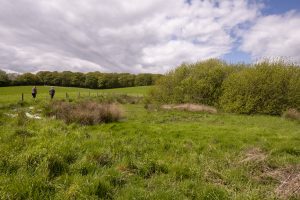Freshwater Habitats Trust fights for irreplaceable ponds
6th October 2022
Freshwater Habitats Trust is asking the UK Government to recognise some of England’s ponds as irreplaceable habitats.
As part of the Environment Act 2021 and the Government’s 25 Year Environment Plan, Defra is identifying habitats that are ‘irreplaceable’ – with ‘irreplaceable’ defined as habitats that can’t be recreated within 100 years. This classification provides habitats with protection against future development.
As features that can be created, ponds were not due to be included in the category of irreplaceable habitats. This means that not even Priority ponds with exceptional biodiversity value would be protected. However, with the support of staff at Natural England, Freshwater Habitats Trust has managed to get two types of pond considered by Defra as irreplaceable habitat types:
- Ice-age ponds (including kettle holes, pingos and other ground-ice ponds, and small tarns)
- Ponds with long established floating vegetation mats and a moss layer
This would give at least some of our most critical freshwater habitats protection.
Now, the national wildlife conservation charity is calling on people in the environmental sector to provide information on ‘Ponds with long established floating vegetation mats and a moss layer’. Although these waterbodies are found across England, there is insufficient data on their whereabouts.

To fulfil the criteria, waterbodies must:
- Be ponds (waterbodies less than 2ha, including seasonal ponds)
- Have a floating mat of vegetation with emergent plants
- Have a moss layer
To give these pond types a chance of being included as irreplaceable habitats in policy, Freshwater Habitats Trust will provide Natural England and Defra with a map, description and method of identification.
Freshwater Habitats Trust Technical Manager Penny Williams said: “Ponds are a critically important but undervalued part of the freshwater network and many are priority habitats with irreplaceable freshwater communities. Evidence shows that, together, they support more biodiversity than large waterbodies, including more rare species. The fact that they were due to be left out of the ‘irreplaceable habitats’ category is therefore extremely worrying.
“Without this recognition, these small waterbodies risk having no protection against destruction when new planning policies come into force.
“That’s why we are so keen for people with knowledge of these two types of ponds to send us examples that we can add to a map. The main gap is currently locations of ponds with floating mats, because, although this is a widespread pond type, it has been poorly recognised in Britain.
“We believe that, with this information, we can put forward a strong case for these ponds to be formally recognised as being irreplaceable and given the same protection as other critical habitats for wildlife.”
To submit information on the location of ponds with floating rafts of moss and vegetation please email Penny Williams (pwilliams@freshwaterhabitats.org.uk) by Thursday 13 October with a grid reference and the year the waterbody was recorded.
For more information on the two waterbody types, please read 4 10 22 Pond irreplaceable habitats floating mats and ice-age ponds This document, Defining and Mapping Pond Irreplaceable Habitat, has been prepared by Penny Williams, Will Watson, Giles King-Salter and Martin Hammond.
